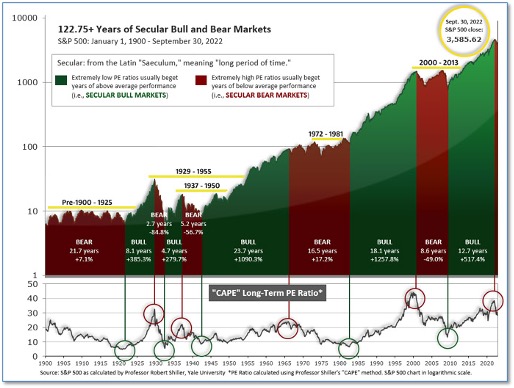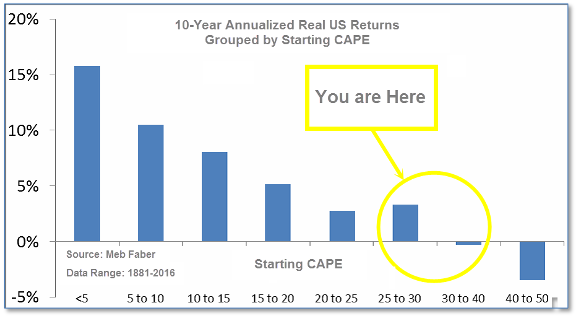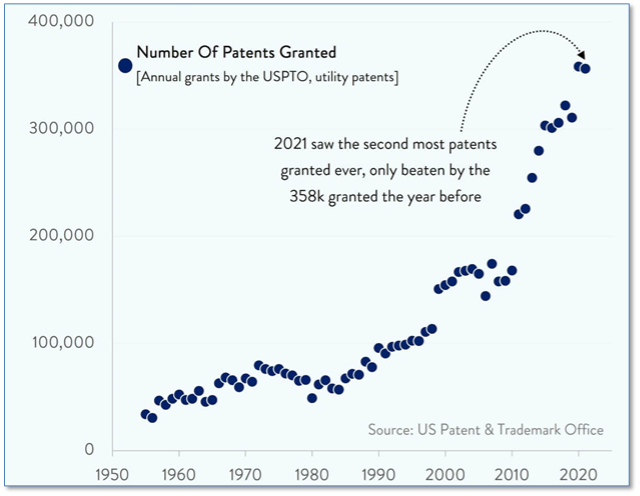January 2023 Innovative Technologies
Submitted by The Blakeley Group, Inc. on January 22nd, 2023The very big picture (a historical perspective):
The long-term valuation of the market is commonly measured by the Cyclically Adjusted Price to Earnings ratio, or “CAPE”, which smooths-out shorter-term earnings swings in order to get a longer-term assessment of market valuation. A CAPE level of 30 is considered to be the upper end of the normal range, and the level at which further PE-ratio expansion comes to a halt (meaning that further increases in market prices only occur as a general response to earnings increases, instead of rising “just because”). The market was recently above that level, and has fallen back.
Of course, a “mania” could come along and drive prices higher - much higher, even - and for some years to come. Manias occur when valuation no longer seems to matter, and caution is thrown completely to the wind - as buyers rush in to buy first, and ask questions later. Two manias in the last century - the “Roaring Twenties” of the 1920s, and the “Tech Bubble” of the late 1990s - show that the sky is the limit when common sense is overcome by a blind desire to buy. But, of course, the piper must be paid, and the following decade or two were spent in Secular Bear Markets, giving most or all of the mania-gains back.
The Very Big Picture: 120 Years of Secular Bulls and Bears

Figure 1
See Fig. 1 for the 100-year view of Secular Bulls and Bears. The CAPE is now at 29.24, up from the prior week’s 28.48. Since 1881, the average annual return for all ten-year periods that began with a CAPE in this range has been slightly positive to slightly negative (see Fig. 2).
The Very Big Picture: Historical CAPE Values
Current reading: 29.24

Figure 2
Note: We do not use CAPE as an official input into our methods. However, if history is any guide - and history is typically ‘some’ kind of guide - it’s always good to simply know where we are on the historic continuum, where that may lead, and what sort of expectations one may wish to hold in order to craft an investment strategy that works in any market ‘season’ … whether the current one, or one that may be ‘coming soon’!
The big picture:
As a reading of our Bull-Bear Indicator for U.S. Equities (comparative measurements over a rolling one-year timeframe), we entered a new Cyclical Bear on March 4, 2022.
The complete picture:
Counting-up of the number of all our indicators that are ‘Up’ for U.S. Equities (see Fig. 3), the current tally is that three of the four are Positive, representing a multitude of timeframes (two that can be solely days/weeks, or months+ at a time; another, a quarter at a time; and lastly, the {typically} years-long reading, that being the Cyclical Bull or Bear status).

In the markets:
U.S. Markets: U.S. stocks recorded a second consecutive week of gains as investors weighed key inflation data and the start of the quarterly earnings reporting season. The NASDAQ Composite and growth-oriented sectors outperformed, helped by rebounds in some mega-cap technology names including Amazon, Tesla, and Microsoft. The Dow Jones Industrial Average rose 2.0% last week, finishing the week at 34,303. The technology-heavy NASDAQ Composite made up some lost ground by rallying 4.8%. By market cap, the large cap S&P 500 added 2.7%, the mid cap S&P 400 gained 3.7% and the small cap Russell 2000 fared the best rallying 5.3%.
International Markets: International markets were a sea of green as well. Canada’s TSX gained 2.8% along with the United Kingdom’s FTSE 100, which added 1.9%. France’s CAC 40 and Germany’s DAX rose 2.4% and 3.3%, respectively. In Asia, China’s Shanghai Composite finished up 1.2%. Japan’s Nikkei managed a 0.6% rise. As grouped by Morgan Stanley Capital International, developed markets finished the week up 3.5%. Emerging markets gained 3.1%.
Commodities: Major commodities also finished the week to the upside. Gold rose 2.8% to $1921.70 per ounce, while Silver gained 1.6% to $24.37. Oil retraced almost the entirety of last week’s plunge. West Texas Intermediate crude oil surged 8.3% to $79.86 per barrel. The industrial metal copper rallied 7.8%.
U.S. Economic News: The number of Americans filing first-time unemployment benefits ticked down slightly as the U.S. labor market remains relatively tight. The Labor Department reported initial jobless claims fell by a seasonally-adjusted 1,000 to 205,000 in the week ended January 7th. Economists had expected claims to rise by 6,000 to 210,000. Initial claims remain near historic lows not seen since the late 1960’s. Meanwhile, the number of people already collecting benefits, known as “continuing claims”, fell by 63,000 to 1.63 million.
The cost of living ticked down last month, posting its first decline since the onset of the coronavirus pandemic in 2020. The Labor Department reported the Consumer Price Index for December fell 0.1% in December, matching economists’ expectations. Furthermore, the annual rate of inflation fell for the sixth month in a row to 6.5% from 7.1%. That’s the lowest level in more than a year and down from its 40-year peak of 9.1% last summer. The core rate of inflation, which omits food and energy prices, rose 0.3% to an annualized 5.7% increase, also matching forecasts. The Federal Reserve views the core rate as a more accurate measure of future inflation trends. Charlie Ripley, senior investment strategist at Allianz Investment Management noted the latest report supports the Federal Reserve’s goal of a ‘soft-landing’ may be attainable after all. “Today’s inflation print is another sign that the Fed’s prescription for bringing down high inflation is working,” he wrote. Sam Bullard, senior economist at Wells Fargo was a bit more cautious writing, “Inflation is moving in the right direction, but I am not sure it offers crystal clear evidence on what the Fed will do in February.”
Confidence among the nation’s small business owners fell to a six-month low in December as sales and business conditions worsened at year-end. The National Federation of Independent Business reported its small-business optimism index fell 2.1 points to 89.8 in December. Economists had expected a slight increase to 92.0. NFIB Chief Economist Bill Dunkelberg said, “Small business owners are not optimistic about 2023 as sales and business conditions are expected to deteriorate.” The survey showed the deterioration in confidence was driven by declining earnings trends due to rising costs of materials and weaker sales. Furthermore, small-business owners still report difficulty finding skilled workers—41% of owners reported job openings that remained unfilled.
Sentiment among the nation’s consumers jumped to a 9-month high given the slowing of inflation and the rebound in equity markets. The University of Michigan reported its preliminary reading of consumer sentiment rose 5 points to 64.7 in January reflecting easing worries about inflation and Americans’ greater confidence in their personal finances. Overall, however, sentiment remains well off its pre-pandemic high of 101. In the details, the gauge that measures what consumers think about their personal financial situation and the current health of the economy climbed to 68.6 last month. Another measure that asks about expectations for the next six months moved up to 62 from 59.9 in the prior month. Overall, Americans viewed inflation as a lessening threat. They expect the inflation rate in the next year to average about 4%, down from 4.4% in the prior month.
Consumers’ expectations of inflation in the short-term continued to decline according to the latest report from the New York Federal Reserve. The regional bank said its December Survey of Consumer Expectations showed inflation running at a 5% rate a year from now. That’s down from 5.2% in November, and its lowest level since July of 2021. Over a longer timeframe of three years, consumers see inflation running at a 3% rate—unchanged from November. Of note, consumer expectations about income growth rose by 0.1% to 4.6%, a new high for the series. The Federal Reserve monitors public perceptions of inflation as future inflation trends tend to mirror expectations.
The Federal Reserve reported total consumer credit rose by $28 billion in November, up 7.1% from the same time last year, as consumers used credit cards amid the worst inflation in forty years. The reading was down slightly from October’s $29.1 billion gain and annual rate of 7.4%, but higher than the consensus forecast of a $26 billion gains. In the report, revolving credit, such as credit cards, rose 16.9% in November up 6.6% from October, while nonrevolving credit, typically auto and student loans, rose 3.9%--down from 6.5% in the prior month. Consumer credit has been growing consistently between $24 billion and $30 billion per month for the past seven months. Nancy Van Houten, economist at Oxford Economics wrote in a note, “The data suggest that consumers are relying more on borrowing to finance consumption in the face of high inflation and dwindling savings.”
In a pair of speeches, Philadelphia Fed President Patrick Harker and St. Louis Fed President gave similar messages regarding the path the Federal Reserve should take to tame inflation. In a speech to the Main Line Chamber of Commerce in Philadelphia, Harker stated the Federal Reserve should raise its benchmark interest rate slightly above 5% and then pause. “I expect that we will raise rates a few more times this year, though, to my mind, the days of us raising them 75 basis points at a time have surely passed. In my view, hikes of 25 basis points will be appropriate going forward,” Harker said. In St. Louis, Fed President James Bullard stated the Federal Reserve’s policy of “front-loading” interest-rate hikes last year was a success and should be continued. Getting interest rates above 5% is needed to put downward pressure on inflation, Bullard said, in a streamed discussion with bankers from several Midwestern states. The Fed raised its benchmark rate by 50 basis points in December to a range of 4.25%-4.5%. The Fed has penciled in 75 basis points of additional rate hikes in 2023.
International Economic News: Canada, Mexico, and the U.S. agreed to strengthen economic ties to reinforce domestic production in North America. In Mexico City, Mexican President Andres Manuel Lopez Obrador, Canadian Prime Minister Justin Trudeau, and U.S. President Joe Biden met to revitalize supply chains after disruptions from the COVID-19 pandemic. President Obrador said that a committee for import substitution would be created to promote economic development, while the White House stated the region would organize a semiconductor forum to increase investment in that industry. “We’re working to a future to strengthen our cooperation on supply chains and critical minerals so we can continue to accelerate in our efforts to build the technologies of tomorrow--right here in North America,” Biden said in a joint news conference with his fellow leaders.
Across the Atlantic, the United Kingdom’s economy grew unexpectedly in November as the tight job market increased demand for employment services and the World Cup boosted hospitality. Gross domestic product, the broadest measure of economic activity, increased 0.1% from the previous month, the Office for National Statistics said. That beat the expectations of economists, who had forecast a 0.2% contraction. Growth in the service sector offset a decline in manufacturing, the ONS said. Manufacturing declined 0.5% in November and construction activity stagnated in the month.
On Europe’s mainland, power prices in France have surged after the launch of two nuclear reactors was delayed due to repairs. The country’s state-run electrical utility said last month the closures have condemned France to two years of low energy output at the height of Europe’s energy crisis. Dozens of the country’s reactors are offline due to maintenance or corrosion. French power prices for next month gained the most in two weeks, rising as much as 3.9%.
Europe’s economic powerhouse, Germany, managed to stave off a recession last year with its economy performing better than expected. According to Germany’s federal statistics agency, Destatis, the German economy grew 1.9% last year, down from 2.6% in 2021. Data suggests that a boost delivered to private consumption by government fiscal support measures, combined with the lifting of coronavirus lockdowns outweighed the economic fallout from the war in Ukraine. “According to the current data, the economic slowdown over the [winter months] will be milder and shorter than expected,” the Economy Ministry said. The reading exceeded the mid-range forecast of growth of 1.8%.
In Asia, China’s exports tumbled sharply in December. Customs data showed exports contracted an annualized ‑9.9% in December, a deeper decline from their -8.7% drop in November. The decline was the worst since February of 2020. Notably, outbound shipments to the United States shrank -19.5% in December, while those to the EU fell -17.5%. Zhiwei Zhang, chief economist at Pinpoint Asset Management stated, “The weak export growth highlights the importance of boosting domestic demand as the key driver for the economy in 2023.” China’s policymakers have pledged to increase support for the economy as they are eager to stimulate growth and ease disruptions caused by the sudden end to COVID-19 curbs.
The Bank of Japan offered a more optimistic view of that country’s economic health, pointing to a growing number of firms planning on wage increases in the new year. In addition, a rebound in overseas tourism driven by Japan’s re-opening of its borders and weaker yen also boosted consumption. In its quarterly report, the BOJ raised its economic assessment of four of the country’s nine regions and maintained its assessment for the remaining five. Also in Japan, the United States and Japan vowed a stronger security cooperation to counter China’s rapid economic and military growth. Senior US and Japanese diplomats and defense officials pledged to strengthen security ties and better integrate weapons systems and military personnel as tensions mount in East Asia.
Finally: The Consumer Electronics Show (CES), the world's largest technology trade show, offers a glimpse into products coming down the pipeline. This year, the ever-expanding field of products showcased everything from color-changing cars to an oven that prevents food from burning. As one would expect, most of the innovative technologies on display at CES are covered by patents, and digging through patent filings is a popular way of picking up on future tech trends. Filings mentioning "metaverse", for example, have risen significantly, as have those mentioning "foldable technology", "electric vehicles" and "sustainable technology". In the latest data from the U.S. Patent and Trademark Office, 2020 and 2021 saw the most patents granted ever—with over 350,000 new patents being granted each of those years. (Chart from chartr.co)

(Sources: All index- and returns-data from Yahoo Finance; news from Reuters, Barron’s, Wall St. Journal, Bloomberg.com, ft.com, guggenheimpartners.com, zerohedge.com, ritholtz.com, markit.com, financialpost.com, Eurostat, Statistics Canada, Yahoo! Finance, stocksandnews.com, marketwatch.com, wantchinatimes.com, BBC, 361capital.com, pensionpartners.com, cnbc.com, FactSet.)

